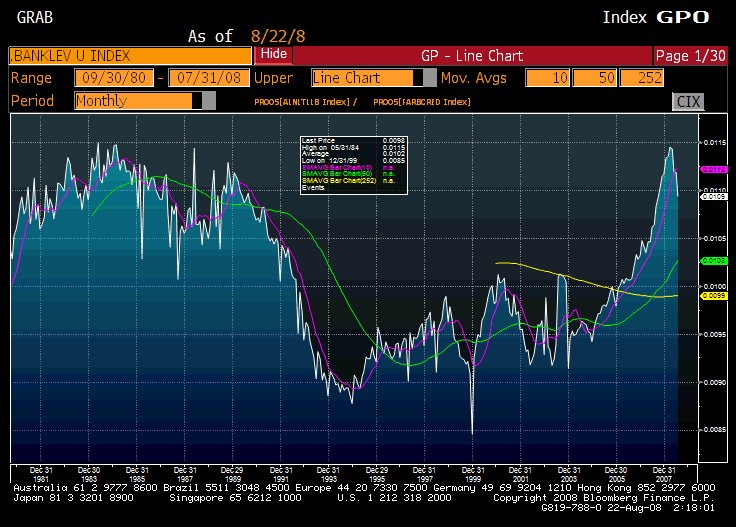The Fundamentals of Market Bottoms, Part 3 (Final)
12) Value investors find no lack of promising ideas, only a lack of capital.
13) Well-capitalized investors that rarely borrow, do so to take advantage of bargains.? They also buy sectors that rarely attractive to them, but figure that if they buy and hold for ten years, they will end up with something better.
14) Neophyte investors leave the game, alleging the the stock market is rigged, and put their money in something that they understand that is presently hot — e.g. money market funds, collectibles, gold, real estate — they chase the next trend in search of easy money.
15) Short interest reaches high levels; interest in hedged strategies reaches manic levels.
Changes in Corporate Behavior
1) Primary IPOs don’t get done, and what few that get done are only the highest quality. Secondary IPOs get done to reflate damaged balance sheets, but the degree of dilution is poisonous to the stock prices.
2) Private equity holds onto their deals longer, because the IPO exit door is shut.? Raising new money is hard; returns are low.
3) There are more earnings disappointments, and guidance goes lower for the future.? The bottom is close when disappointments hit, and the stock barely reacts, as if the market were saying “So what else is new?”
4) Leverage reduces, and companies begin talking about how strong their balance sheets are.? Weaker companies talk about how they will make it, and that their banks are on board, committing credit, waiving covenants, etc.? The weakest die.? Default rates spike during a market bottom, and only when prescient investors note that the amount of companies with questionable credit has declined to an amount that no longer poses systemic risk, does the market as a whole start to rally.
5) Accounting tends to get cleaned up, and operating earnings become closer to net earnings.? As business ramps down, free cash flow begins to rise, and becomes a larger proportion of earnings.
6) Cash flow at stronger firms enables them to begin buying bargain assets of weaker and bankrupt firms.
7) Dividends stop getting cut on net, and begin to rise, and the same for buybacks.
Other Indicators
1) Implied volatility is high, as is actual volatility. Investors are pulling their hair, biting their tongues, and retreating from the market. The market gets scared easily, and it is not hard to make the market go up or down a lot.
2)The Fed adds liquidity to the system, and the response is sluggish at best.? By the time the bottom comes, the yield curve has a strong positive slope.
No Bottom Yet
There are some reasons for optimism in the present environment.? Shorts are feared.? Value investors are seeing more and more ideas that are intriguing.? Credit-sensitive names have been hurt.? The yield curve has a positive slope.? Short interest is pretty high.? But a bottom is not with us yet, for the following reasons:
- Implied volatility is low.
- Corporate defaults are not at crisis levels yet.
- Housing prices still have further to fall.
- Bear markets have duration, and this one has been pretty short so far.
- Leverage hasn’t decreased much.? In particular, the investment banks need to de-lever, including the synthetic leverage in their swap books.
- The Fed is not adding liquidity to the system.
- I don’t sense true panic among investors yet.? Not enough neophytes have left the game.
Not all of the indicators that I put forth have to appear for there to be a market bottom. A preponderance of them appearing would make me consider the possibility, and that is not the case now.
Some of my indicators are vague and require subjective judgment. But they’re better than nothing, and kept me in the game in 2001-2002. I hope that I — and you — can achieve the same with them as we near the next bottom.
For the shorts, you have more time to play, but time is running out till we get back to more ordinary markets, where the shorts have it tough.? Exacerbating that will be all of the neophyte shorts that have piled on in this bear market.? This includes retail, but also institutional (130/30 strategies, market neutral hedge and mutual funds, credit hedge funds, and more).? There is a limit to how much shorting can go on before it becomes crowded, and technicals start dominating market fundamentals.? In most cases, (i.e. companies with moderately strong balance sheets) shorting has no impact on the ultimate outcome for the company — it is just a side bet that will eventually wash out, following the fundamental prospects of the firm.
As for asset allocators, time to begin edging back into equities, but I would still be below target weight.
The current market environment is not as overvalued as it was a year ago, and there are some reasonably valued companies with seemingly clean accounting to buy at present.? That said, long investors must be willing to endure pain for a while longer, and take defensive measures in terms of the quality of companies that they buy, as well as the industries in question.? Long only investors must play defense here, and there will be a reward when the bottom comes.
=-=-=-=-=-=-=-==-=-=-=-=-=
That’s all for this post.? After comments are in, I will reformat the piece as one post and republish it.


